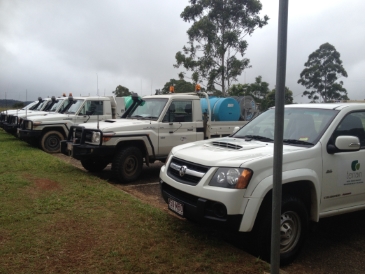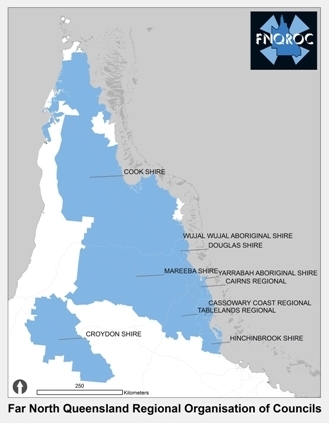Even though the Wet Tropics region provides perfect conditions for many weeds, the region is famous for its collaborative and strategic approach to pest and weed (invasive species) prioritisation and management.
There is complete alignment across the Local Governments of this region in the way they approach prioritisation, and the decision making processes they have in place.
The levels of planning in Queensland
In Queensland, there are 2 formally recognised levels of planning for invasive species. At the highest level, Biosecurity Queensland takes the lead in setting policy, priorities and regulation about the management of invasive species in the state. Planning at the local level is required to align with these State priorities, addressing these priorities in the local context. National pest and weed priorities also inform state and local-level planning.
At the Local Government level, Pest Management Plans, aligned with the State and National priorities, set out the specific actions that will be undertaken to manage invasive species in the local area. Across the State, there is no agreed standard, format or approach to local planning, making alignment across local government boundaries difficult. There is no formal requirement for neighbouring councils to formally collaborate on invasive species planning or management.
Invasive species planning in the Wet Tropics
Unlike any other area of the state, the local councils of Far North Queensland have joined forces to undertake collective strategic planning for invasive species management. With technical and facilitation support from the Far North Queensland Regional Organisation of Councils (FNQROC) this region has developed and implemented a cutting edge, regional planning framework in a bid to direct precious investment to get the best outcome possible.
This framework assists Local Governments to develop clear, measurable and easily communicated management targets, which guide ongoing effort, rather than one-off, reactive investments. The framework provides universal approaches to mapping, prioritising and assigning management aims to pests and weeds, whilst retaining the vital local needs and values required for uptake and delivery.
Operating alone, none of the Local Governments would have the resources to develop the sophisticated decision making framework that is now used across the FNQROC region.
This collective planning also fosters a collaborative management culture between councils. Councils in the region pool resources and collaborate across borders. A classic example is the formation of cross-border task forces, which assemble to work on a particular priority in a target location. These taskforces are important for not only dealing with invasive species issues but also help to build the skills and capacity of participating groups.
Although not required by law, in 2009 the councils of the FNQROC developed a FNQ Regional Pest Management Plan. This plan brings together the common cross-border priorities and issues, aggregating these up to the regional level in order to agree on priorities for investment. (FNQROC regional pest management strategy 2010-2015)
This regional plan sits above the individual Local Pest Management Plans. All FNQROC councils have completed, or are in the process of completing new zoned and prioritised Local Pest Management Plans which align with, and cascade down from the regional Pest Management Plan. All local planning applies the agreed prioritisation process, leading to full alignment between councils.
Community input into regional planning
Far North Queensland Pest Advisory Forum (PAF) is Queensland’s longest running community-based pest management forum. It provides the opportunity for the community of stakeholders to have input into regional policy and planning processes in the Wet Tropics. It is also a learning and networking opportunity and provides community with direct access to decision makers and those deciding on where the resources should be spent.
Facilitated jointly by Biosecurity Queensland, FNQROC and Terrain, this forum meets several times a year in different locations around the region, and commonly attracts a wide variety of stakeholders, from farmers to community groups to Traditional Owners.
Really Useful Links
FNQROC webpage http://www.fnqroc.qld.gov.au/regional-programs/natural-asset-management
Local Government invasive species landing pages:
Hinchinbrook Shire Council https://www.hinchinbrook.qld.gov.au/community-environment/land-and-pest-management/
Cassowary Coast Regional Council http://www.cassowarycoast.qld.gov.au/weed-management
Cairns Regional Council http://www.cairns.qld.gov.au/community-environment/natural-resource-management/regional-pest-management
Tablelands Regional Council http://www.trc.qld.gov.au/environmental-servicesinformation/pest-weeds-and-feral-animal-management/
Mareeba Shire Council http://msc.qld.gov.au/pests-weeds/
Douglas Shire Council http://douglas.qld.gov.au/environment-water-and-waste/pest-management/

